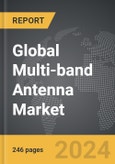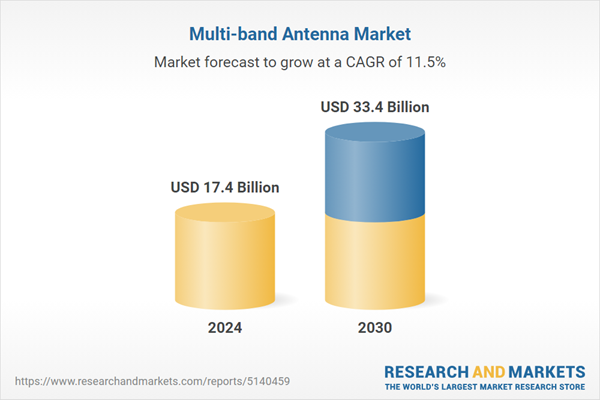Global Multi-Band Antenna Market - Key Trends & Drivers Summarized
What Are Multi-Band Antennas and How Do They Work?
A multi-band antenna is an advanced antenna system designed to operate across multiple frequency bands, enabling the transmission and reception of signals over a broad range of frequencies. Unlike single-band antennas, multi-band antennas can support multiple communication technologies, such as cellular networks (2G, 3G, 4G, 5G), Wi-Fi, GPS, and Bluetooth, all within the same device. This versatility makes them ideal for modern applications where seamless connectivity across different frequencies is required. These antennas are found in a variety of devices, from smartphones and IoT sensors to vehicles and communication infrastructures. By leveraging multi-band antennas, manufacturers can minimize the need for multiple antennas in a single device, reducing space and improving efficiency.What Are the Major Technological Advances Driving Multi-Band Antenna Development?
The evolution of 5G networks and the growing complexity of communication systems are significantly driving innovations in multi-band antenna technology. One of the key advancements is the development of smaller, more efficient antennas that can operate across the wide spectrum of frequencies needed for 5G communication, including both sub-6 GHz and millimeter-wave frequencies. The shift towards Massive MIMO (Multiple Input, Multiple Output) technology is another critical trend. This technology allows for better utilization of available bandwidth by supporting multiple data streams, which is essential for high-speed data transfer and enhanced connectivity in dense urban environments. Additionally, advancements in materials science are enabling the production of lightweight, flexible antennas, allowing for easier integration into compact devices like smartphones and wearables, while maintaining strong performance across multiple bands.How Is the Rise of IoT and Connected Devices Driving Demand for Multi-Band Antennas?
The Internet of Things (IoT) revolution has significantly impacted the demand for multi-band antennas, as more devices require reliable, multi-frequency communication. From smart home devices to industrial automation systems, IoT applications rely on multi-band antennas to transmit and receive data across various protocols, ensuring continuous, stable connectivity. As the number of connected devices grows, the need for antennas capable of handling different communication standards, such as Wi-Fi, Bluetooth, and LoRa, is becoming more prominent. Moreover, the automotive industry is increasingly integrating multi-band antennas into vehicles to support features like real-time navigation, vehicle-to-everything (V2X) communication, and infotainment systems. As consumers demand more connected experiences, multi-band antennas are playing a vital role in enabling this level of integration and interconnectivity across a broad range of devices and sectors.What Are the Key Growth Drivers in the Multi-Band Antenna Market?
The growth in the multi-band antenna market is driven by several factors, including the rapid deployment of 5G networks, the increasing adoption of IoT devices, and advancements in smart technologies. The rollout of 5G is perhaps the most significant driver, as it requires antennas that can operate across a wider frequency range to ensure faster speeds and better connectivity. Additionally, the proliferation of connected devices in the IoT landscape is pushing demand for versatile antennas that can support multiple communication protocols simultaneously. In the automotive industry, the growing need for advanced in-car communication systems and real-time data sharing is further fueling the demand for multi-band antennas. Moreover, consumer demand for more efficient, compact, and high-performance devices, particularly in the smartphone and wearable segments, is propelling technological innovation and driving the market for multi-band antennas.Report Scope
The report analyzes the Multi-band Antenna market, presented in terms of units. The analysis covers the key segments and geographic regions outlined below.Segments: End-Use (Wireless Communication, Aerospace & Defense, Automotive, Other End-Uses).
Geographic Regions/Countries: World; United States; Canada; Japan; China; Europe (France; Germany; Italy; United Kingdom; and Rest of Europe); Asia-Pacific; Rest of World.
Key Insights:
- Market Growth: Understand the significant growth trajectory of the Wireless Communication segment, which is expected to reach US$17.5 Billion by 2030 with a CAGR of a 13.0%. The Aerospace & Defense segment is also set to grow at 10.6% CAGR over the analysis period.
- Regional Analysis: Gain insights into the U.S. market, valued at $4.7 Billion in 2024, and China, forecasted to grow at an impressive 10.4% CAGR to reach $5.0 Billion by 2030. Discover growth trends in other key regions, including Japan, Canada, Germany, and the Asia-Pacific.
Why You Should Buy This Report:
- Detailed Market Analysis: Access a thorough analysis of the Global Multi-band Antenna Market, covering all major geographic regions and market segments.
- Competitive Insights: Get an overview of the competitive landscape, including the market presence of major players across different geographies.
- Future Trends and Drivers: Understand the key trends and drivers shaping the future of the Global Multi-band Antenna Market.
- Actionable Insights: Benefit from actionable insights that can help you identify new revenue opportunities and make strategic business decisions.
Key Questions Answered:
- How is the Global Multi-band Antenna Market expected to evolve by 2030?
- What are the main drivers and restraints affecting the market?
- Which market segments will grow the most over the forecast period?
- How will market shares for different regions and segments change by 2030?
- Who are the leading players in the market, and what are their prospects?
Report Features:
- Comprehensive Market Data: Independent analysis of annual sales and market forecasts in US$ Million from 2024 to 2030.
- In-Depth Regional Analysis: Detailed insights into key markets, including the U.S., China, Japan, Canada, Europe, Asia-Pacific, Latin America, Middle East, and Africa.
- Company Profiles: Coverage of players such as 2J Antennas, Aarc Technologies Company Limited, Alaris Antennas, Baiao Electronics Technology, Baylin Technologies and more.
- Complimentary Updates: Receive free report updates for one year to keep you informed of the latest market developments.
Some of the 46 companies featured in this Multi-band Antenna market report include:
- 2J Antennas
- Aarc Technologies Company Limited
- Alaris Antennas
- Baiao Electronics Technology
- Baylin Technologies
- Benelec Pty., Ltd.
- Comba Telecom Systems Holdings Ltd.
- EnduroSat
- Galtronics Corporation
- Helical Communication Technologies
Tariff Impact Analysis: Key Insights for 2025
Global tariff negotiations across 180+ countries are reshaping supply chains, costs, and competitiveness. This report reflects the latest developments as of April 2025 and incorporates forward-looking insights into the market outlook.The analysts continuously track trade developments worldwide, drawing insights from leading global economists and over 200 industry and policy institutions, including think tanks, trade organizations, and national economic advisory bodies. This intelligence is integrated into forecasting models to provide timely, data-driven analysis of emerging risks and opportunities.
What’s Included in This Edition:
- Tariff-adjusted market forecasts by region and segment
- Analysis of cost and supply chain implications by sourcing and trade exposure
- Strategic insights into geographic shifts
Buyers receive a free July 2025 update with:
- Finalized tariff impacts and new trade agreement effects
- Updated projections reflecting global sourcing and cost shifts
- Expanded country-specific coverage across the industry
Table of Contents
Companies Mentioned (Partial List)
A selection of companies mentioned in this report includes, but is not limited to:
- 2J Antennas
- Aarc Technologies Company Limited
- Alaris Antennas
- Baiao Electronics Technology
- Baylin Technologies
- Benelec Pty., Ltd.
- Comba Telecom Systems Holdings Ltd.
- EnduroSat
- Galtronics Corporation
- Helical Communication Technologies
Table Information
| Report Attribute | Details |
|---|---|
| No. of Pages | 246 |
| Published | April 2025 |
| Forecast Period | 2024 - 2030 |
| Estimated Market Value ( USD | $ 17.4 Billion |
| Forecasted Market Value ( USD | $ 33.4 Billion |
| Compound Annual Growth Rate | 11.5% |
| Regions Covered | Global |









